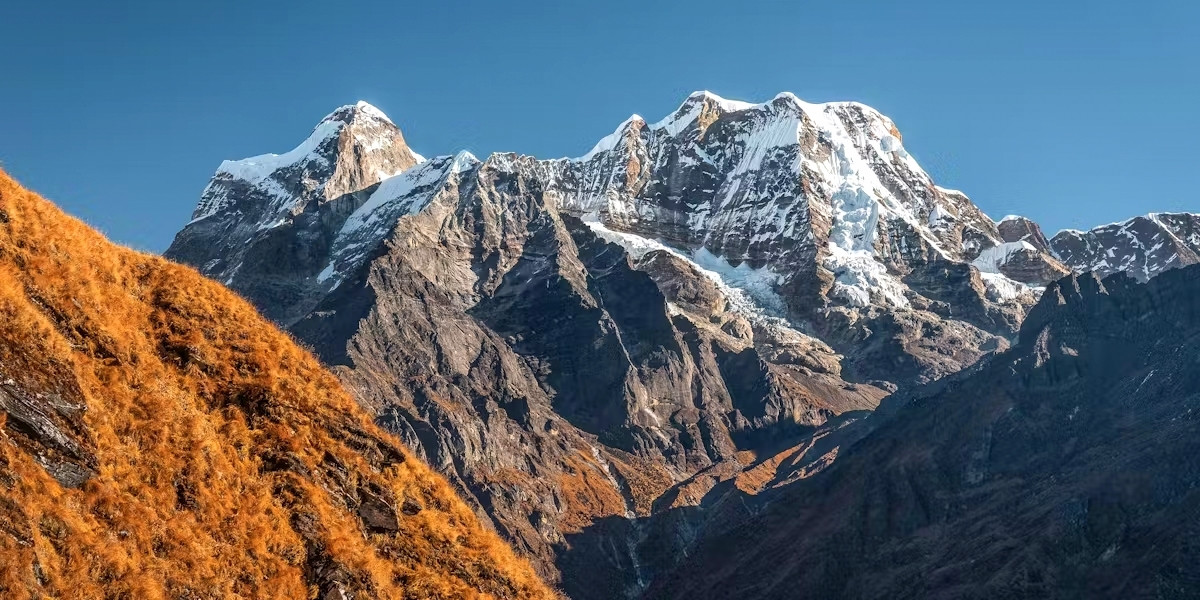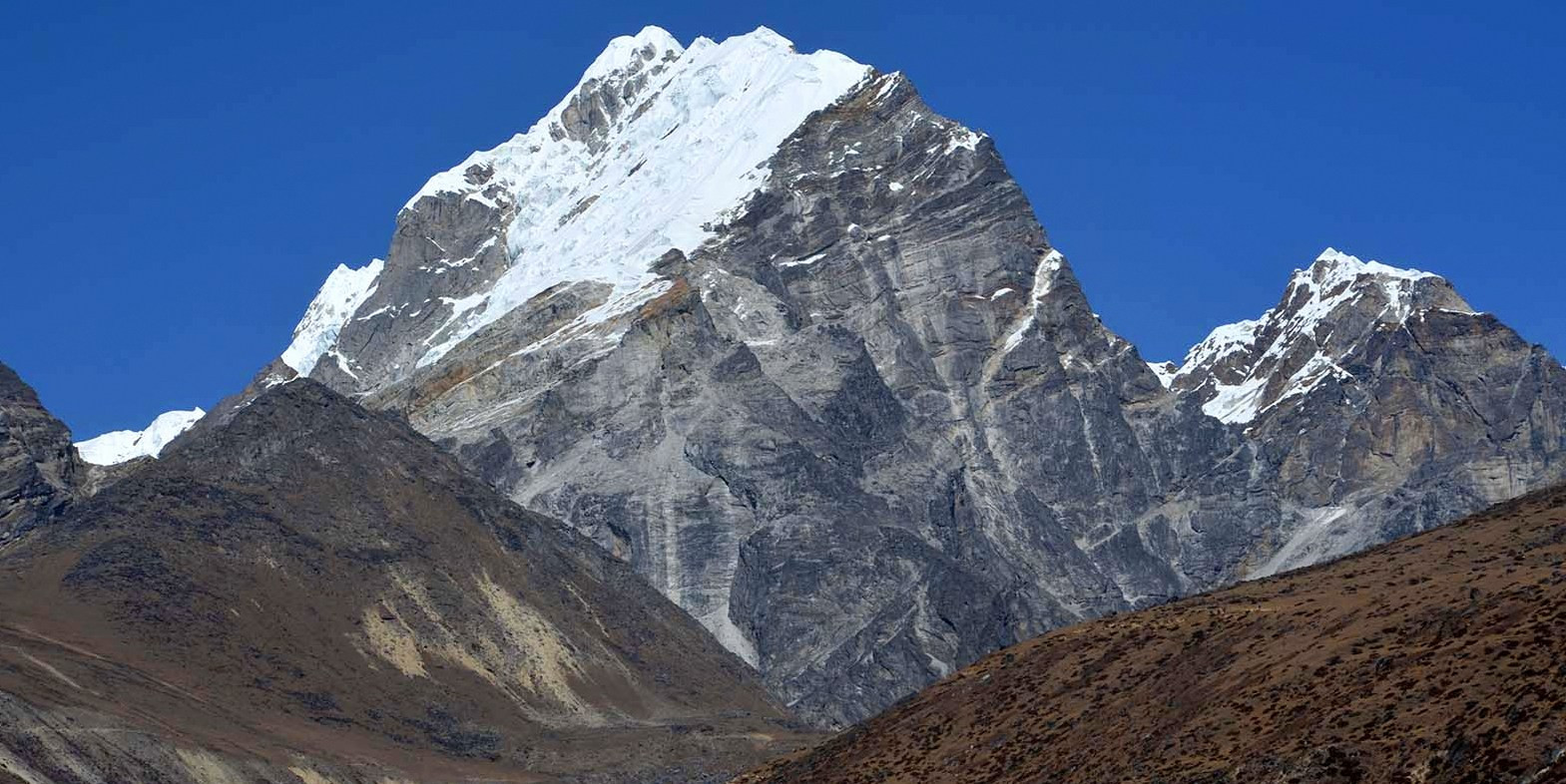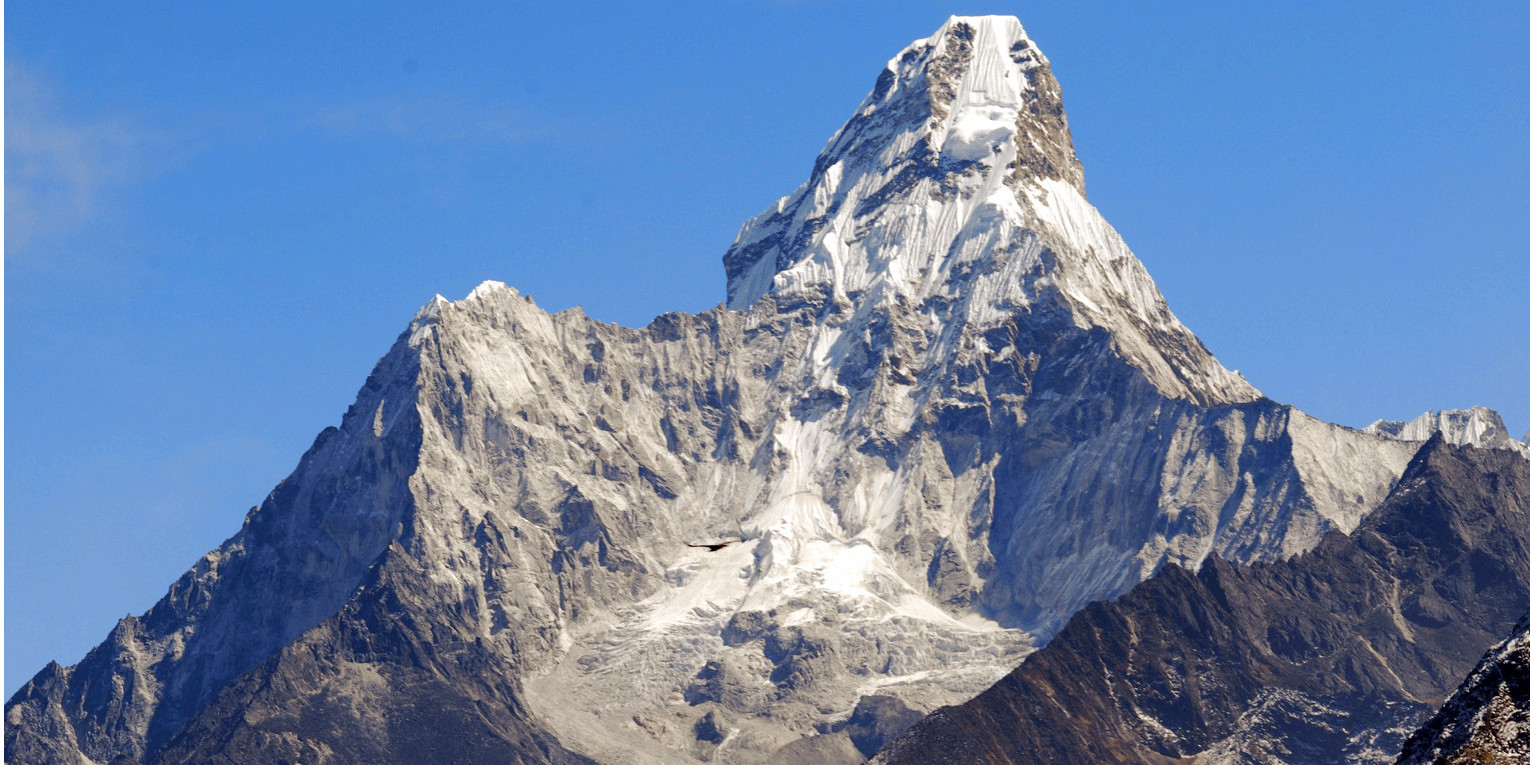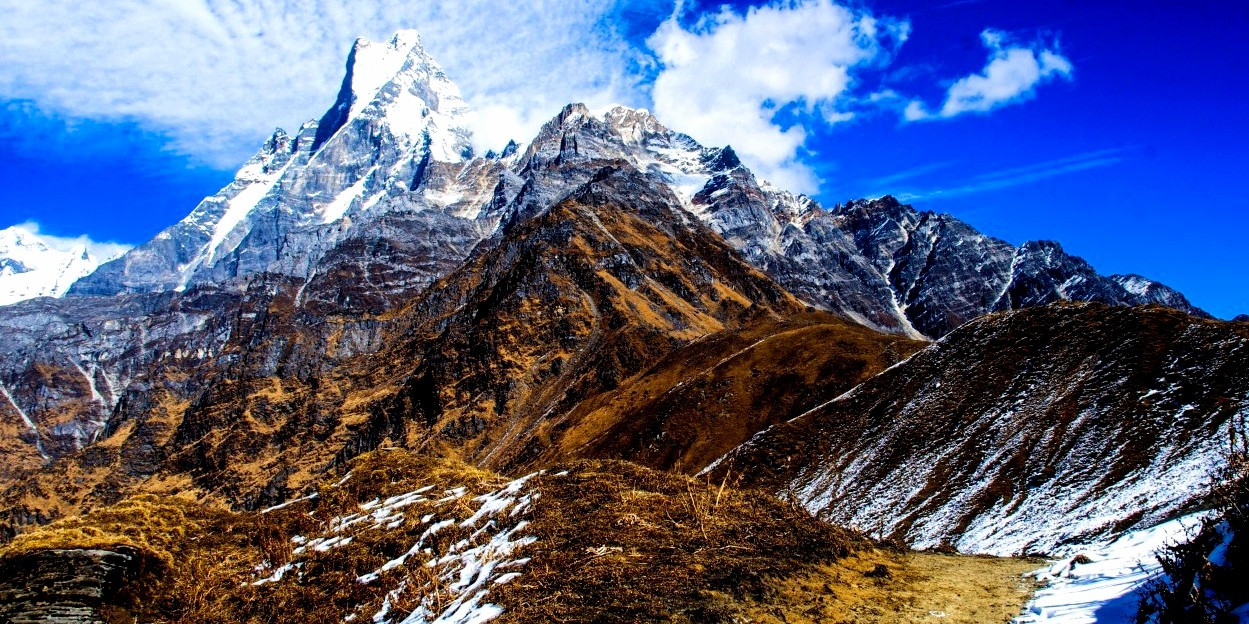Island Peak (Imja Tse) - 6,165 m
Island Peak, also known as Imja Tse, stands at an elevation of 6,165 meters in the heart of the Everest region in Nepal. This peak is a favored destination for climbers and trekkers alike, offering an achievable challenge for those looking to experience high-altitude mountaineering without the technical difficulties associated with the taller 8000m giants.
 2.jpg)
-
Accessible Adventure: Island Peak is considered one of the most accessible options for climbers looking to venture above 6000m, making it an excellent introduction to high-altitude climbing.
-
Stunning Scenery: The climb provides breathtaking views of the surrounding Himalayan giants, including Mount Everest, Lhotse, Nuptse, and Ama Dablam, offering climbers a truly immersive experience in the majesty of the world's highest mountain range.
-
Technical Aspects: While mostly non-technical, the final ascent involves some ice climbing and the negotiation of crevasses, presenting a thrilling challenge for those new to mountaineering. This makes it a perfect peak for aspiring mountaineers to develop their skills.
-
Rich Cultural Experience: The journey to Island Peak involves trekking through the famous Khumbu Valley, home to the Sherpa community, allowing climbers to experience the rich culture and hospitality of this region.
-
Acclimatization Opportunity: Climbers often use Island Peak as an acclimatization climb before attempting higher peaks in the Everest region, making it a strategic part of many climbers' journeys in the Himalayas.
-
Permits and Preparation: Climbers need to secure a climbing permit, typically arranged by their expedition company. Preparation for Island Peak involves physical conditioning, familiarity with basic mountaineering equipment, and, ideally, some pre-climb training on ice and snow. It's recommended that climbers undertake acclimatization hikes and spend several days adjusting to the altitude before attempting the summit.
Choosing to climb Island Peak with Relax Getaways means opting for an experience that combines adventure with safety and cultural immersion. We provide expert guidance, comprehensive support, and a deep understanding of the mountain environment to ensure our clients have a memorable and rewarding climbing experience. Whether you're taking your first steps into high-altitude climbing or preparing for bigger challenges, Island Peak offers a spectacular introduction to the wonders of the Himalayas.
Mera Peak - 6,476m
Mera Peak, towering at an elevation of 6,476 meters, is renowned as the highest trekking peak in Nepal, situated in the remote and spectacular Hinku Valley. This peak offers a unique blend of challenging adventure and the opportunity to stand on a summit with one of the most breathtaking panoramic views in the Himalayas. Climbing Mera Peak is an adventure that combines glacier travel, a straightforward but long ascent, and exposure to high altitude, making it an ideal objective for climbers looking to experience their first Himalayan summit.

-
Spectacular Panoramic Views: From its summit, climbers are rewarded with stunning views of five of the world's 8000m peaks - Mount Everest, Lhotse, Cho Oyu, Makalu, and Kanchenjunga, offering an unparalleled mountain vista.
-
Non-Technical Climb: Mera Peak is predominantly a non-technical climb, but it requires basic mountaineering skills, such as using an ice axe and crampons, making it accessible to climbers with limited alpine experience.
-
High-Altitude Experience: As the highest trekking peak in Nepal, Mera Peak provides climbers with a significant high-altitude experience, making it a perfect peak for those looking to test their response to higher elevations.
-
Remote and Pristine Location: The approach to Mera Peak traverses through the beautiful and less-traveled Hinku Valley, offering a more secluded and pristine Himalayan experience compared to more crowded routes in the Everest region.
-
Acclimatization and Preparation: The climb requires careful acclimatization due to its high altitude. The journey to Mera Peak itself serves as a fantastic acclimatization process, with several days of trekking through varied landscapes.
-
Permits and Logistics: Mera Peak requires a trekking peak permit, which can be arranged through a registered trekking agency. Additionally, climbers should be physically fit and prepared for the rigors of high-altitude trekking and climbing. While it is a non-technical peak, familiarity with basic mountaineering equipment and techniques is beneficial.
Mera Peak adventure with Relax Getaways ensures you have the support of experienced guides and a well-planned itinerary that prioritizes acclimatization and safety. We provide comprehensive logistical support, from permits and equipment to expert guidance on the mountain, making your climb as enjoyable as it is memorable. Climbing Mera Peak with us is not just about reaching the summit; it's about experiencing the beauty and solitude of the Himalayas, learning about the local culture, and challenging yourself in one of the most stunning settings on Earth.
Lobuche East - 6,119m
Lobuche East, standing at an elevation of 6,119 meters, is one of the popular trekking peaks in the Everest region of Nepal. Unlike its neighboring giants, Lobuche East offers a unique blend of technical challenge and accessibility, making it a favorite among climbers looking to push their skills beyond the trekking trails and into the realm of mountaineering. Its summit provides stunning vistas of the Everest massif, including views of Everest, Lhotse, Nuptse, and Ama Dablam, among others.

-
Technical Ascent: While Lobuche East is accessible to climbers with basic mountaineering skills, it presents a more technical challenge than other trekking peaks such as Island Peak. The climb involves navigating through steep snow and ice sections, requiring the use of ice axes, crampons, and ropes.
-
Stunning Himalayan Panoramas: The summit offers one of the most spectacular views in the Everest region, with panoramic sights of some of the highest peaks in the world.
-
Ideal Preparation for Higher Peaks: Climbing Lobuche East is often seen as a stepping stone for climbers aiming to tackle more significant and more technically demanding mountains in the future.
-
Rich Cultural Experience: The journey to Lobuche East goes through the heart of the Sherpa homeland, offering climbers a chance to experience the rich culture and hospitality of the Everest region.
-
Permits and Preparation: Climbers need to secure a climbing permit for Lobuche East, which can be arranged through a registered trekking agency like Relax Getaways. Preparation for Lobuche East should include physical conditioning, familiarization with technical climbing gear, and ideally, some prior experience with high-altitude trekking or climbing. The climb also requires careful acclimatization to minimize the risk of altitude sickness.
Choosing Relax Getaways for your Lobuche East expedition means choosing a partner dedicated to providing a safe, rewarding, and enriching climbing experience. Our experienced guides, who are intimately familiar with the Everest region's unique challenges and beauty, will lead you every step of the way. We offer comprehensive logistical support, from permits and equipment to tailored itineraries that prioritize your safety, enjoyment, and the chance to immerse yourself fully in the high Himalayas. Climbing Lobuche East with us is an adventure that combines the thrill of technical mountaineering with the awe-inspiring beauty of the world's highest peaks, all while ensuring the highest standards of safety and environmental responsibility.
Pisang Peak - 6,091 m
Pisang Peak, rising to 6,091 meters in the Annapurna region of Nepal, offers a compelling blend of trekking and mountaineering to those drawn to the Himalayas. This peak is an attractive option for climbers who wish to experience the thrill of reaching a Himalayan summit while enjoying the scenic beauty and cultural richness of the Annapurna Circuit. The ascent combines moderate trekking with basic alpine climbing, making it a suitable challenge for both seasoned trekkers and novice mountaineers.
-
Diverse Climbing Experience: Pisang Peak provides climbers with a mix of trekking through diverse landscapes and undertaking an alpine ascent that requires basic mountaineering skills.
-
Spectacular Annapurna Views: From its summit, climbers are treated to panoramic views of the Annapurna range, including Annapurna II and IV, Gangapurna, and the Manaslu massif.
-
Cultural Immersion: The approach to Pisang Peak traverses through the Annapurna Circuit, offering opportunities to immerse in the local culture, visit traditional villages, and experience the warm hospitality of the Gurung and Manangi communities.
-
Accessible Challenge: While the climb involves steep snow and ice slopes, it is considered one of the more accessible options for those new to mountaineering, with the right preparation and guidance.
-
Permits and Preparation: To climb Pisang Peak, climbers need to obtain a trekking peak permit, which can be arranged through a reputable trekking agency. Adequate physical preparation, acclimatization to the altitude, and familiarity with basic mountaineering equipment are essential for a successful and enjoyable ascent. Climbers should also consider engaging in pre-climb training that includes ice climbing and working with ropes.
Pisang Peak adventure with Relax Getaways means you'll be supported by a team dedicated to making your climb safe, enjoyable, and memorable. We take care of all logistical aspects, including permits, gear, and route planning, allowing you to focus on the climb and the stunning landscapes around you. Our experienced guides are not only skilled climbers but also knowledgeable about the local culture and environment, enriching your journey to the summit. Climbing Pisang Peak with Relax Getaways offers an unparalleled opportunity to challenge yourself, learn new skills, and experience the beauty and culture of the Annapurna region responsibly and sustainably.
Ama Dablam - 6,812m
Ama Dablam, soaring to an elevation of 6,812 meters, is one of the most iconic and stunning mountains in the Everest region of Nepal, often referred to as the "Matterhorn of the Himalayas" due to its distinctive, sharply pointed shape. This peak is renowned not only for its breathtaking beauty but also for the technical climbing challenge it presents, attracting experienced mountaineers from around the globe who seek to test their skills against its steep slopes and narrow ridges.

-
Technical Climbing Paradise: Ama Dablam demands a high level of technical mountaineering skills, including rock and ice climbing, as well as the ability to navigate its famed narrow ridges and steep faces.
-
Spectacular Scenery: The climb offers unparalleled views of the Himalayan giants, including Everest, Lhotse, and Makalu, providing a backdrop that is truly without equality.
-
Cultural Journey: The approach to Ama Dablam traverses through the legendary Khumbu Valley, offering climbers a chance to immerse themselves in the rich Sherpa culture and visit famous landmarks such as the Tengboche Monastery.
-
High-Altitude Adventure: At over 6,800 meters, Ama Dablam provides climbers with a significant high-altitude experience, testing their endurance and acclimatization capabilities.
-
Permits and Preparation: Climbing Ama Dablam requires a permit from the Nepal Mountaineering Association, which can be obtained through a registered expedition company. Due to its technical nature, climbers should be well-versed in advanced mountaineering techniques and have prior experience with high-altitude climbs. Rigorous physical preparation, technical training, and thorough acclimatization are crucial for a successful ascent.
Choosing Relax Getaways for your Ama Dablam expedition ensures you have the support of a team that values safety, experience, and cultural respect. Our seasoned guides, who have extensive knowledge of the mountain's unique challenges and conditions, are committed to providing climbers with a meticulously planned and executed ascent. We handle all logistics, from permits to camp setup, allowing you to focus fully on the climb. Climbing Ama Dablam with us is not just an expedition; it's an unforgettable journey through one of the most beautiful and challenging landscapes on Earth, enriched by the culture and hospitality of the Sherpa community.
Tharpu Chuli (Tent Peak) - 5,695 m
Tharpu Chuli, also known as Tent Peak, stands at an elevation of 5,695 meters and is nestled in the heart of the Annapurna Sanctuary, surrounded by the majestic peaks of the Annapurna range. This peak offers climbers an excellent introduction to Himalayan mountaineering, providing a manageable challenge for those with basic alpine skills and a desire to experience the thrill of reaching a high-altitude summit. Its relatively lower elevation and non-technical nature make Tharpu Chuli an appealing choice for trekkers looking to transition into peak climbing.
.jpg)
-
Accessible Climbing Experience: Tharpu Chuli is perfect for beginners and those new to mountaineering, offering an achievable summit without the need for advanced technical skills.
-
Stunning Panoramic Views: The summit provides climbers with breathtaking views of the Annapurna massif, including Annapurna South, Hiunchuli, Machhapuchhre (Fishtail), and the surrounding peaks, offering a 360-degree Himalayan panorama.
-
Rich Cultural Journey: The approach to Tharpu Chuli passes through diverse landscapes and vibrant Gurung villages, allowing climbers to immerse themselves in the local culture and traditions of the Annapurna region.
-
Ideal Acclimatization Peak: For those planning to tackle higher peaks, Tharpu Chuli serves as an excellent acclimatization climb, offering the chance to adjust to high-altitude conditions in a controlled and gradual manner.
-
Permits and Preparation: Climbers need to secure a climbing permit for Tharpu Chuli, which can be arranged through a reputable trekking agency. While the climb is considered non-technical, good physical condition, basic trekking and mountaineering skills, and proper acclimatization are essential for a safe and enjoyable ascent. Familiarity with basic climbing equipment, such as ice axes and crampons, is also recommended.
Tharpu Chuli expedition with Relax Getaways means choosing a partner committed to providing an unforgettable adventure that combines the thrill of climbing with safety, environmental stewardship, and cultural respect. Our experienced guides, well-versed in the unique challenges and beauty of the Annapurna Sanctuary, will ensure your climb is safe, enjoyable, and rewarding. We handle all aspects of the expedition, from permits and equipment to itinerary planning and camp setup, allowing you to focus on the climb and the stunning natural beauty around you. Climbing Tharpu Chuli with Relax Getaways offers a unique opportunity to experience the magic of the Himalayas, challenge yourself, and create lasting memories in one of the world's most extraordinary mountain landscapes.
Tips for Best 6000m Peaks in Nepal
Climbing a 6000m peak in Nepal is an adventure that offers immense rewards, including stunning landscapes, a sense of achievement, and the opportunity to push your limits. To ensure your expedition is successful and enjoyable, here are some essential tips to consider:
-
Choose the Right Peak: Assess your skills, experience, and fitness level to select a peak that matches your abilities. For beginners, peaks like Island Peak or Mera Peak offer a good start, while more experienced climbers might aim for technically challenging peaks like Ama Dablam.
-
Prepare Physically and Mentally: High-altitude climbing demands excellent physical condition. Engage in cardiovascular exercises, strength training, and altitude training if possible. Mental preparation is equally important; be ready to face challenges and stay positive.
-
Acquire the Necessary Skills: Basic mountaineering skills, such as using an ice axe, crampons, and understanding glacier travel, are essential. Consider taking a mountaineering course to brush up on these skills.
-
Understand Altitude Sickness: Familiarize yourself with the symptoms of Acute Mountain Sickness (AMS) and more severe conditions like HAPE and HACE. Learn about acclimatization processes and follow a slow ascent profile to give your body time to adjust.
-
Hire a Reputable Guide or Join a Guided Expedition: A knowledgeable guide or an experienced expedition company can significantly enhance your safety and success rate. Look for companies with a good track record, like Relax Getaways, especially if you're attempting one of the more challenging peaks.
-
Get the Right Gear: Invest in high-quality climbing gear and clothing suitable for extreme cold and variable weather conditions. Always test your equipment before the expedition.
-
Obtain Necessary Permits: Ensure you have all the required permits for your chosen peak. Your expedition company can usually handle this for you, but it’s good to be informed about the necessary documentation.
-
Plan for the Best Season: The pre-monsoon (spring) and post-monsoon (autumn) seasons are generally the best times to climb 6000m peaks in Nepal, offering more stable weather and clearer views.
-
Respect Local Culture and Environment: The Himalayas are not just a climbing destination but also a place of cultural significance and delicate ecosystems. Be respectful of local customs and minimize your environmental impact.
-
Stay Flexible: Weather and health issues can lead to changes in your climbing itinerary. Be prepared to adjust your plans and always prioritize safety over summiting.
6000m peak expedition in Nepal is a formidable and thrilling challenge. With the right preparation, a respectful approach to the mountains, and guidance from seasoned professionals, climbers can look forward to an enriching and unforgettable experience.
Health and Safety for Best 6000m Peaks in Nepal
When undertaking expeditions to the best 6000m peaks in Nepal, prioritizing health and safety is crucial. The high-altitude environment poses unique challenges, including extreme weather, potential for altitude sickness, and the physical demands of climbing. Here are essential health and safety guidelines to ensure a successful and safe climbing experience:
-
Acclimatization and Altitude Sickness: Recognize Altitude Sickness Symptoms: Be aware of the symptoms of Acute Mountain Sickness (AMS) and its more severe forms, High Altitude Pulmonary Edema (HAPE) and High Altitude Cerebral Edema (HACE). Symptoms include headache, nausea, dizziness, and breathlessness.
-
Physical Fitness and Training: Pre-Expedition Fitness: Engage in a training regimen that includes cardiovascular exercises, strength training, and hikes with a weighted backpack to simulate climbing conditions.
-
Nutrition and Hydration: Stay Hydrated: Drink plenty of water to prevent dehydration, which can exacerbate the effects of altitude sickness.
-
Medical Check-Up and Insurance: Pre-Expedition Medical Check-Up: Undergo a comprehensive medical examination to ensure you're fit for high-altitude climbing.
-
Emergency Preparedness: Carry a First Aid Kit: Your kit should include medications for altitude sickness, painkillers, antiseptic, bandages, and any personal medications.
-
Climbing Gear and Equipment: Quality Gear: Use high-quality, well-maintained climbing gear and personal equipment suited for extreme cold and varying weather conditions.
-
Guides and Porters: Experienced Guides: Hire experienced, licensed guides familiar with the region and its challenges. Their knowledge and expertise are invaluable for safety and success.
-
Environmental Considerations: Minimize Impact: Follow the principles of Leave No Trace to protect the fragile mountain environment. Carry out all waste, and use established campsites.
-
Weather Awareness: Stay Informed: Keep updated on weather forecasts and conditions. Be prepared to adjust your plans or turn back if conditions deteriorate.
-
Mental Preparedness: Psychological Resilience: High-altitude climbing can be as much a mental challenge as a physical one. Be prepared for the psychological strains and maintain a positive, flexible attitude.
By adhering to these health and safety guidelines, climbers can significantly reduce the risks associated with high-altitude expeditions and increase their chances of a rewarding experience on the 6000m peaks of Nepal.
Best Time to Climb 6000m Peaks in Nepal
The best time to climb 6000m peaks in Nepal is typically during the country's two main trekking seasons: pre-monsoon (spring) and post-monsoon (autumn). These periods are favored due to their generally stable weather, moderate temperatures, and clear skies, which not only facilitate safer climbing conditions but also enhance the overall experience with spectacular views.
Pre-Monsoon (Spring) Season: March to May
-
Advantages: The spring season brings warmer weather, making high-altitude conditions more bearable. This is also the time when the Himalayas are in full bloom, with rhododendrons and wildflowers covering the trails, adding to the beauty of the expedition. The visibility is generally good, with clear mornings and occasional afternoon clouds.
-
Considerations: As the season progresses, temperatures rise, which can increase the risk of avalanches in certain areas. It's also a popular season, meaning that trails and base camps can be crowded, especially on well-trodden routes like those to Everest Base Camp or the Annapurna Circuit.
Post-Monsoon (Autumn) Season: September to November
-
Advantages: Autumn is considered by many as the optimal climbing season due to its stable weather and clear skies. The monsoon rains clear the air of dust and pollution, resulting in excellent visibility and breathtaking mountain vistas. Temperatures are generally moderate, making for comfortable climbing conditions.
-
Considerations: Nights can be colder compared to the spring, and as the season moves towards winter, temperatures will drop further, especially at higher altitudes. Like spring, autumn sees a high volume of trekkers and climbers, so popular peaks can be quite busy.
Off-Peak Seasons: Winter and Summer
-
Winter (December to February): Climbing during the winter months is possible but poses additional challenges due to colder temperatures, shorter days, and the increased likelihood of snow and ice on the trails. Some peaks may be more difficult or dangerous to climb in these conditions.
-
Summer/Monsoon (June to August): The monsoon season is generally considered unsuitable for high-altitude climbing in Nepal due to heavy rains, reduced visibility, and the increased risk of landslides and leeches on lower trails. However, some rain-shadow areas like Upper Mustang and parts of the Dolpo region remain viable options for trekking.
Choosing the right time to climb depends on various factors, including the specific peak, your tolerance for cold, your experience level, and your preference for solitude versus sharing the route with others. Regardless of when you choose to go, always be prepared for the unpredictable nature of mountain weather and have a flexible itinerary to accommodate changes.
Summiting the best 6000m peaks in Nepal offers climbers an exhilarating blend of adventure, natural beauty, and personal challenge. These peaks, accessible to both novices and experienced mountaineers, present unique opportunities to engage with the Himalayas' majestic heights. Optimal climbing seasons—spring and autumn—promise stable weather and clear views, enhancing the summit experience. Safety, acclimatization, and respect for local cultures and environments are crucial for a successful climb. Whether seeking the thrill of a first summit or the challenge of a technical ascent, Nepal's 6000m peaks provide unforgettable adventures that test limits and foster a deep connection with nature. In essence, these climbs are not just physical journeys but profound experiences that resonate long after the descent.
FAQs for Best 6000m Peaks in Nepal
Q: What are the best 6000m peaks in Nepal for beginners?
A: For beginners, Island Peak (Imja Tse) and Mera Peak are considered ideal due to their relatively easier routes and minimal technical requirements, offering an excellent introduction to high-altitude climbing.
Q: Do I need previous mountaineering experience to climb a 6000m peak in Nepal?
A: Previous experience is beneficial but not mandatory for certain peaks like Island Peak or Mera Peak, which are suitable for beginners with basic trekking experience and good physical condition. Preparation and acclimatization are key, and a guided expedition can provide necessary training.
Q: What is the best time to climb 6000m peaks in Nepal?
A: The optimal times are during the pre-monsoon (spring) season from March to May and the post-monsoon (autumn) season from September to November, offering stable weather and clearer skies.
Q: What gear do I need for climbing 6000m peaks in Nepal?
A: Essential gear includes warm clothing, mountaineering boots, crampons, an ice axe, a helmet, and a harness. Additional gear like ropes and carabiners may be required for technical climbs. Personal items like sunglasses and sunscreen are also recommended.
Q: How do I acclimatize for a 6000m peak climb?
A: Acclimatization involves spending several days at increasing altitudes to adjust to lower oxygen levels. It’s important to ascend to higher altitudes during the day but sleep at lower altitudes and include rest days in your itinerary.
Q: Are permits required to climb 6000m peaks in Nepal?
A: Yes, a climbing permit from the Nepal Mountaineering Association (NMA) and a TIMS card are required. Expedition companies usually arrange these permits.
Q: How long does it take to climb a 6000m peak in Nepal?
A: Expeditions can range from 10 to 20 days, including acclimatization and the trek to and from the base camp, depending on the peak, route, and weather conditions.
Q: Can I climb a 6000m peak solo in Nepal?
A: Climbing solo is possible but not recommended, especially for those with limited experience. Hiring a local guide not only enhances safety but also supports the local economy. Regulations may require climbers to be accompanied by a licensed guide for certain peaks.
For the Nepal tour, please click here.
If you are looking for different kinds of Nepal Tours or Trekking Packages, feel free to contact us.


 2.jpg)



.jpg)
